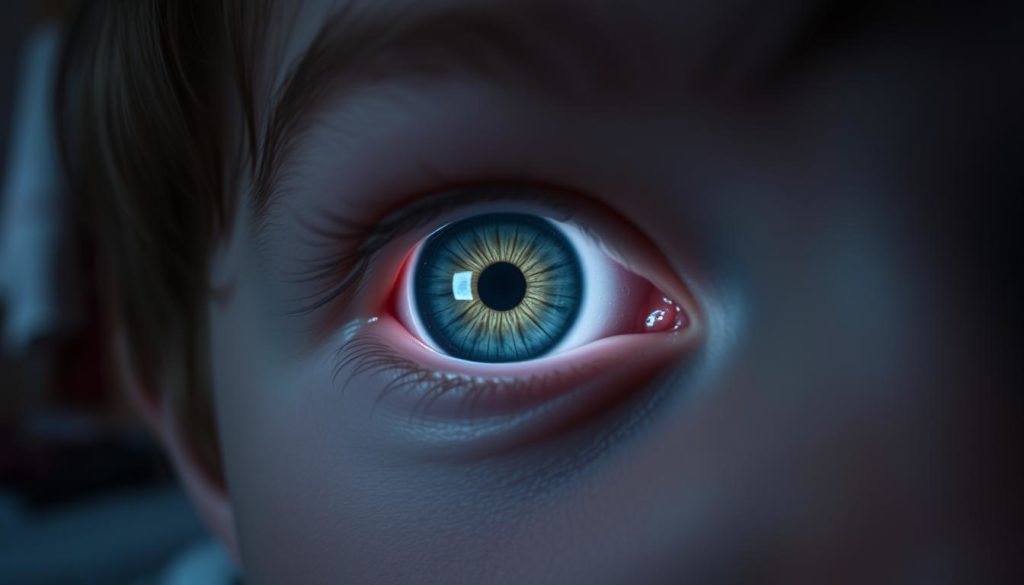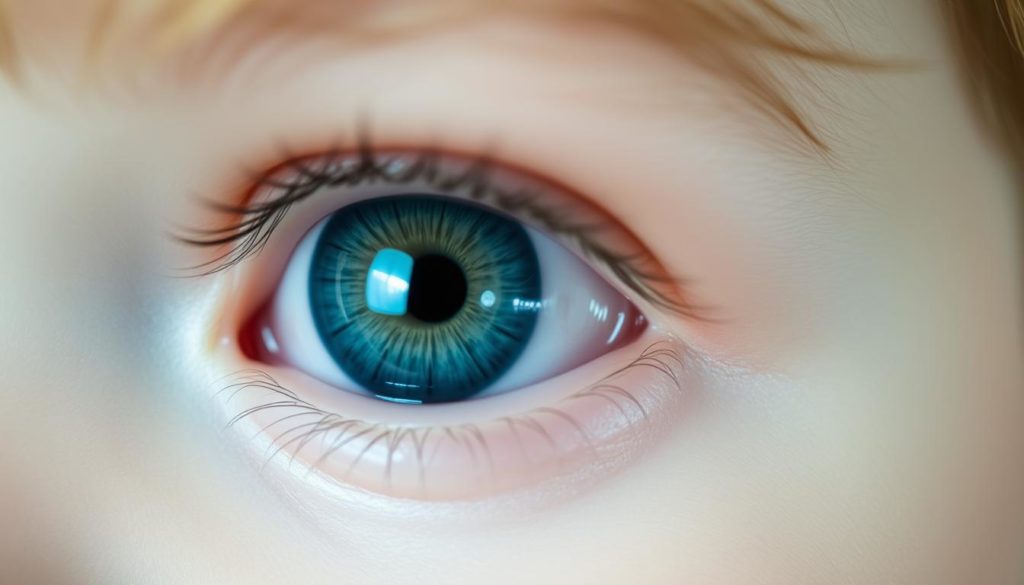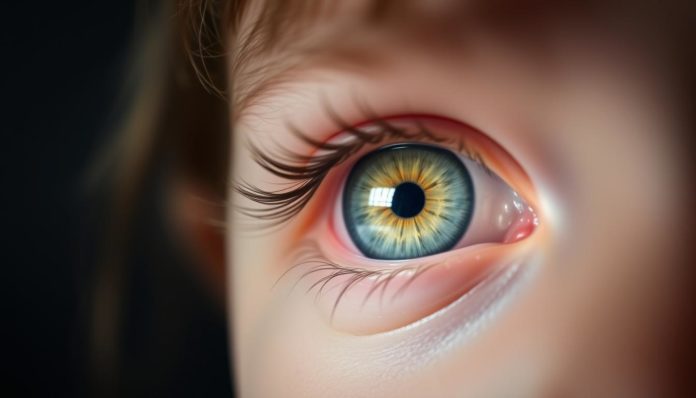“The greatest enemy of knowledge is not ignorance, it is the illusion of knowledge.” – Stephen Hawking
Leukocoria is more than just a white spot in the pupil. It can signal serious health issues. Spotting leukocoria early is crucial for saving eyesight and lives. Knowing the causes and signs helps parents and caregivers act fast.
What Is Leukocoria?
Leukocoria is a condition where a white reflection is seen in the pupil. It could mean there’s an underlying eye disease. This is often noticed in photos or dim light, where the pupil looks white or yellowish instead of red.

Definition and Overview
Knowing What Is Leukocoria? is key for eye health. It comes from Greek words for “white” and “pupil.” It’s not a disease but a sign of serious eye issues like retinoblastoma or cataracts. These problems need quick diagnosis and treatment to avoid serious vision loss.
Importance of Awareness
It’s vital to raise awareness about leukocoria for early detection. By knowing what leukocoria is and its signs, we can get help fast. More awareness and regular eye checks can greatly help those affected, showing the importance of proactive healthcare.
Common Leukocoria Symptoms
Leukocoria is a serious eye condition that needs early detection. Knowing the leukocoria symptoms is key to getting help quickly. This part will cover the visual and behavioral signs of leukocoria.
Visual Warning Signs
A white reflection in the pupil is a clear sign of leukocoria, often seen in flash photos. This “white eye” look is different from red-eye reduction. Other eye disease symptoms include uneven pupil sizes, poor vision, and odd eye movements.

Behavioral Indications
Behavioral changes can also point to leukocoria symptoms. Kids might have trouble following objects, squint a lot, or tilt their head to see. These signs suggest vision problems and need a doctor’s check-up.
Possible Causes of Leukocoria
Understanding leukocoria causes is key for the right treatment. Several pediatric eye conditions can cause leukocoria, showing as a white eye reflection. A serious cause is retinoblastoma, a cancer in the retina. It mainly hits young kids and can cause blindness if not treated fast.
Coats’ disease is another big cause. It’s a rare condition that affects the retina’s blood vessels. It can lead to blindness if not caught early. Spotting it early is crucial to avoid lasting damage.
Congenital cataracts can also cause leukocoria. These cataracts are there from birth and can block normal vision growth. Early treatment is vital to help kids see better.
Here’s a quick look at these main leukocoria causes:
| Condition | Key Characteristics | Potential Outcomes |
|---|---|---|
| Retinoblastoma | Malignant tumor of the retina | Can lead to blindness, requires immediate treatment |
| Coats’ Disease | Abnormal development of retinal vessels | Leads to visual impairment, gradual vision loss |
| Congenital Cataracts | Clouding of the eye’s lens present at birth | Can cause significant visual impairment if untreated |
Healthcare providers need to think about these pediatric eye conditions when they see leukocoria in kids. Quick diagnosis and treatment can really help kids see better and live better lives.
How Leukocoria Affects Children
Leukocoria in children is a serious condition that can harm their vision and growth. It’s crucial to catch it early to avoid lasting vision problems or blindness.
Early Detection Importance
Finding eye diseases like leukocoria early is key to protecting a child’s sight. Regular eye checks and watching for signs like white pupils are important. Early action can stop vision issues from getting worse.
Long-Term Effects
Ignoring leukocoria can cause lasting harm. It can lead to permanent blindness, affecting school and social life. It also impacts a child’s mental and emotional health, making everyday life harder.
| Aspect | Impact |
|---|---|
| Vision | Can lead to blindness if not detected and treated early. |
| Academic Performance | Difficulties in learning and reading due to impaired vision. |
| Social Development | Challenges in interacting with peers, leading to potential isolation. |
| Psychological Well-being | Potential onset of anxiety and low self-esteem due to vision problems. |
Knowing how leukocoria can affect kids shows why finding eye diseases early is so important. Parents and doctors must work together to catch and treat it quickly. This protects a child’s future vision and well-being.
The Diagnosis Process for Leukocoria
Diagnosing leukocoria is a key step that uses many techniques and technologies. This detailed approach is vital for accurate detection. It helps in early intervention and management.
Physical Examination Techniques
The first step in diagnosing leukocoria is a thorough ophthalmic examination by healthcare providers. They use:
- Inspection of the retina using an ophthalmoscope
- Red reflex test to check for normal and abnormal reflections
- Visual acuity tests
These methods help doctors spot any abnormal whiteness in the eye. This leads to early detection of leukocoria.
Advanced Diagnostic Tools
When physical exams suggest leukocoria, advanced technology is used to confirm the diagnosis. It helps understand the underlying causes.
- Ultrasound Imaging: Commonly used to get a detailed view of the eye’s interior structures.
- CT Scans: Provides cross-sectional images of the eye to detect abnormalities.
- MRI Scans: Employs magnetic fields to produce high-resolution images for a comprehensive assessment.
The use of these advanced technologies gives a clearer picture of the eye’s condition. It aids in effective detection and treatment planning.
Available Treatment Options for Leukocoria
There are many ways to treat leukocoria, each with its own benefits. Knowing these options helps in making the best choices for patient care.
Non-Surgical Treatments
Laser therapy is a non-surgical method for treating leukocoria. It uses lasers to target and remove abnormal tissue without harming healthy areas. Another non-surgical option is cryotherapy, which freezes and destroys abnormal cells.
Surgical Interventions
Sometimes, surgery is needed to treat leukocoria. Procedures like vitrectomy and lensectomy remove the affected parts of the eye. This helps restore vision and prevents more problems. These surgeries require skilled ophthalmologists for the best results.
Post-Treatment Care
After treatment, whether it’s laser therapy or surgery, follow-up care is key. Regular check-ups help track healing and catch any problems early. Rehabilitation may include eye exercises, medications, or more treatments to keep vision healthy long-term.
| Treatment Option | Method | Advantages |
|---|---|---|
| Non-Surgical | Laser Therapy | Precision, minimal damage to surrounding tissues |
| Non-Surgical | Cryotherapy | Effective in destroying abnormal cells |
| Surgical | Vitrectomy | Removes affected eye sections |
| Surgical | Lensectomy | Restores vision, prevents complications |
Preventative Measures for Leukocoria
Not all leukocoria causes can be stopped, but we can take steps to help. One key action is regular eye health checks for kids. These checks are crucial for catching eye problems early.
Parents should watch their kids’ eyes closely. Small changes in eye look or how it works can mean trouble. Catching these signs early and getting ocular disease screening can help a lot.
Knowing your family’s health history is also important. It can tell you about risks you might face. Talking to doctors about this can help you know how to protect your kids:
- Scheduling routine eye exams for children
- Observing for unusual eye reflections or appearance
- Maintaining awareness of family history concerning ocular diseases
- Ensuring timely follow-ups with pediatric eye specialists
By doing these things, we can keep our kids’ eyes healthy. This way, we can avoid serious problems and help them see clearly.
Enhancing Leukocoria Awareness
It’s key to raise leukocoria awareness for early detection and treatment. Educational campaigns and community programs are crucial. They spread the word and offer support.
Educational Campaigns
Educational campaigns are vital for vision health. They teach the public and healthcare workers. Using social media, seminars, and workshops, they share vital leukocoria info.
They work with ophthalmologists, pediatricians, and eye health groups. This ensures the info is accurate and reliable.
Community Outreach Programs
Community outreach is key for community health education. These programs offer resources and support for leukocoria families. They use health fairs, school visits, and free screenings to reach more people.
They also give out educational materials and counseling. Building a supportive community is their goal. This helps raise awareness and improve eye health.
| Initiative | Objective | Target Audience |
|---|---|---|
| Social Media Campaigns | Raise awareness about leukocoria symptoms | General public |
| School Vision Screenings | Detect early signs in children | Students and teachers |
| Healthcare Workshops | Educate healthcare professionals | Doctors and nurses |
| Local Health Fairs | Provide resources and support | Community members |
The Role of Pediatricians in Managing Leukocoria
Pediatric health care professionals are key in spotting leukocoria early in kids. Their quick action can greatly improve a child’s health and vision.
Pediatricians are often the first ones parents turn to when worried about their child’s eyes. At check-ups, they look for signs of eye problems. Finding these signs early means kids can get help fast, saving their vision.
Pediatricians use many ways to find eye issues early, including:
- Conducting comprehensive eye examinations
- Using tools like the ophthalmoscope for a closer look at the retina
- Consulting with ophthalmologists when necessary
The success of pediatric care depends on staying updated. Pediatricians need to know the latest in eye care to help their young patients the best way.
| Strategies | Benefits |
|---|---|
| Routine Eye Exams | Early detection of eye diseases |
| Use of Ophthalmoscope | Close examination of the retina |
| Referral to Specialists | Expert intervention for advanced care |
In conclusion, pediatricians are crucial in managing leukocoria. Their knowledge and dedication to early detection are vital for protecting kids’ vision and health.
Case Studies: Personal Stories of Leukocoria
Looking into Leukocoria case studies gives us a peek into the emotional and medical sides of this condition. Families open up about their patient journeys. Doctors share ophthalmology insights that help us understand diagnosis and treatment.
Family Experiences
Maria Gonzales talks about her son David’s fight with leukocoria. From the first white eye reflections to his diagnosis of retinoblastoma. She stresses how early detection helped save his life.
Through many doctor visits and tests, their story shows the strength and willpower of families facing this challenge.
Medical Insights
Dr. Emily Watson, a top pediatric ophthalmologist, talks about the tough part of diagnosing leukocoria. She shares her Leukocoria case studies, pointing out the need for advanced tools. Her knowledge helps us understand the condition better.
For Dr. Watson, each case is a chance to learn and improve care for others. It’s all about making future treatments better.
Additional Resources for Leukocoria Information
Looking for more on leukocoria? There’s a lot of information out there. You can find detailed studies and reports that explain the condition’s causes, symptoms, and treatments. Journals like the “American Journal of Ophthalmology” and “Pediatric Ophthalmology and Strabismus” publish the latest research. This gives you a deeper look into new discoveries and advancements.
There are also many patient support resources available. Organizations like the American Association for Pediatric Ophthalmology and Strabismus (AAPOS) offer support groups and forums. These connect patients with others who understand their experiences, creating a community of shared knowledge.
For expert care and treatment, places like the Mayo Clinic and Johns Hopkins Medicine are great resources. They provide top-notch care and a wealth of information for patients. Getting involved in local healthcare initiatives and educational programs can also help spread awareness. This way, you can support ongoing research aimed at improving patient care.
FAQ
What is leukocoria?
Leukocoria is when you see a white reflection in the pupil. It might mean there’s a serious eye disease. Catching it early is very important.
What are the symptoms of leukocoria?
Signs include a white spot in the pupil and odd eye movements. You might also see eyes that don’t line up right or vision changes. If a child seems off or not focused, it could be a sign too.
What causes leukocoria?
It can happen for many reasons, like retinoblastoma, Coats’ disease, or cataracts at birth. These issues stop the eye’s normal red glow, making it look white.
How is leukocoria diagnosed?
Doctors use eye exams and tools like ultrasound, CT scans, and MRI to find out what’s wrong.
How does leukocoria affect children?
If not caught and treated early, leukocoria can cause big vision problems. Finding it early is key to keeping vision sharp and helping kids grow well.
What treatment options are available for leukocoria?
Treatment depends on the cause. It might include laser therapy, cryotherapy, or surgery. After treatment, kids need care and help to get better fully.
Can leukocoria be prevented?
Some causes can’t be stopped, but regular eye checks and watching for signs can help. Keeping an eye on kids’ eye health is very important.
Why is awareness about leukocoria important?
Knowing about leukocoria helps find and treat it early. This leads to better results for patients. Spreading the word and helping communities is key.
What role do pediatricians play in managing leukocoria?
Pediatricians are key in spotting and handling leukocoria. They can quickly send kids for the right care, making sure they get the help they need fast.
Are there any personal stories or case studies on leukocoria?
Yes, there are many stories and studies about leukocoria. They share the struggles and wins in dealing with it. These stories give insight into the journey and outcomes.
Where can I find more information on leukocoria?
You can find more info in medical papers, patient groups, and special centers. There are also places for advice and ways to get involved in helping others.


